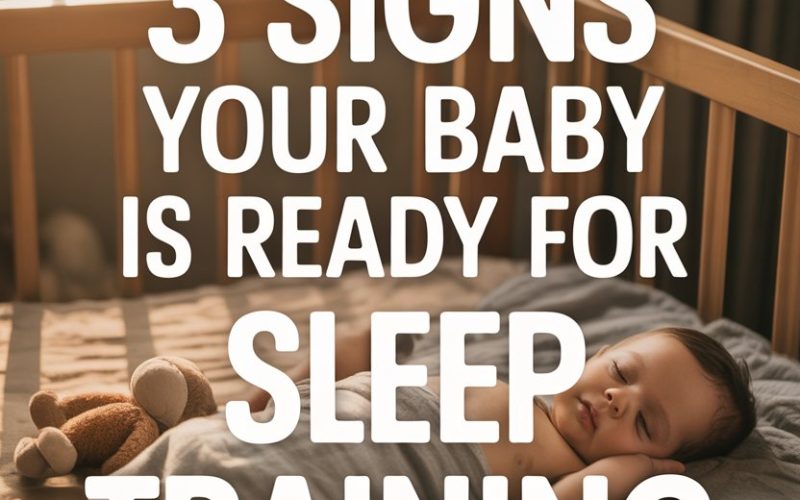Welcome to the hour when you’re pacing the hallway, crooning “Twinkle Twinkle” for the 87th time, wondering if you’ll ever have feeling in your arms again.
If you’re reading this with one eye open and your baby’s stuffed giraffe as a pillow, take heart—you’re not alone.
The sleep-deprived secret society of parents everywhere is right there with you, clutching mugs of cold tea and quietly Googling “Is it time for sleep training?”
Here’s the good news: Even amidst the nighttime chaos, babies do drop hints that they’re ready to master the fine art of self-settling. No need for a decoder ring.
These signs are clear, practical, and yes—might just pave the way for that mythical thing called ‘a full night’s sleep.’
Let’s cut to the chase: When can you start sleep training, and how do you know your little one is primed for the adventure? Here are the three unmistakable signs.
1. Your Baby is Old Enough to Go Longer Stretches Without Feeding
Every new parent hears it: “They’ll sleep through the night when they’re ready!” If only someone had defined “ready,” right? Well, the actual answer lies partly with your baby’s age and development.
Most experts agree that a baby under four months old still needs night feeds, thanks to those tiny tummies and supercharged growth. Around four to six months, things start to shift.
Babies often develop the ability to go at least six hours without feeding at night.
If your child is gaining weight well, your health visitor or paediatrician has given the green light, and you’re not dealing with any medical concerns, you’re in the zone where sleep training becomes realistic.
You’ll notice your little one sometimes wakes for a feed but then only sips a bit, or even falls asleep halfway through. This isn’t just “baby being baby”—it can mean they’re waking out of habit, not hunger.
Sleep scientists have found that many infants are physically able to sleep for longer stretches once they hit this developmental stage.
If you’re still unsure, pay attention to daytime feeds. A baby who’s hungry at night but uninterested during the day might not be ready; one who’s still eager for daytime feeds but just “meh” at 3 a.m. is dropping some big hints.
And if you’re worried about growth spurts or teething throwing a spanner in the works, don’t fret—temporary regressions are normal. What you’re looking for is the overall trend towards fewer, shorter night feeds.
2. Your Baby Has Established Some Day-Night Awareness
It’s the classic baby party trick: wide-eyed and bushy-tailed at midnight, dead to the world at 10 a.m. Babies are born without a clue about “day” and “night” (which is adorable, if you’re not living with one).
But over the first few months, their internal clocks—known as circadian rhythms—begin to develop.
When your little one starts to show longer stretches of sleep at night compared to daytime dozing, you’ve hit a crucial milestone.
Experts at the Sleep Foundation note that by three to four months, many infants begin to sync up with family routines, getting sleepy at similar times each evening and waking at roughly the same hour in the morning.
Notice your baby gets fussy or rubs their eyes every evening around the same time? Or that they’re starting to take more predictable daytime naps?
These are strong clues that their biological clock is ticking along nicely.
Nailing down day-night awareness doesn’t mean you’ll never see 3 a.m. again (sorry), but it does pave the way for teaching self-soothing skills.
When babies naturally get sleepier at night, they’re more receptive to learning new habits, including falling back asleep on their own.
If your little one is still treating 2 a.m. like primetime telly, you might need to focus first on gentle cues: dimming lights at night, keeping things calm and boring (no offense, late-night nappy changes), lots of daylight and activity during the day.
Once those rhythms settle, sleep training can actually work—rather than just feeling like an elaborate new parent prank.
3. Your Baby Can Self-Soothe, Even Just a Little Bit
Here’s the sleep training magic trick everyone talks about, but rarely describes in plain English: self-soothing. The ability to drift off—or back to sleep—without elaborate adult intervention.
No one expects a six-month-old to meditate themselves to sleep, but there are small signs your child is starting to figure things out.
Babies ready for sleep training might:
- Suck their thumb, dummy (pacifier), or a favourite muslin cloth for comfort.
- Wiggle into a comfy position or roll onto their side (once safe to do so).
- Pause after crying, occasionally settling down without a cuddle or feed.
If you’ve ever watched your baby fuss, squawk a little, and then drift off on their own, that’s self-soothing in action. Some nights it’ll look more like a wrestling match with a stuffed rabbit, but hey—it’s progress.
Paediatricians and baby sleep specialists, like those highlighted by the Cleveland Clinic, emphasise that self-soothing doesn’t mean “crying it out” endlessly.
It’s about giving your baby a chance to try, even for a minute or two, before swooping in with midnight cuddles. If your little one can manage this, even occasionally, sleep training is far more likely to succeed.
It’s tempting to jump in at the slightest peep (mum guilt, dad guilt, grandparent guilt—it’s a family affair). Still, babies who are inching towards self-settling benefit from a bit of space to practice their new skills.
What If Your Baby Isn’t Showing These Signs?
Just because your Instagram feed is full of babies snoozing peacefully doesn’t mean yours is behind. Every child hits these milestones at their own pace.
Some are ready for a bit of structured sleep support at four months, while others need a few more weeks—or even months.
Sleep training before a baby is physically and developmentally ready can lead to frustration for both of you. No one wants to “train” a baby who still needs night feeds or is in the thick of a growth spurt.
There’s also no medal for getting it done early. One study published in Pediatrics found that starting sleep training at five months or eight months produced similar results by a baby’s first birthday.
The real win? Finding the timing that works for your family.
If your baby isn’t quite there yet, focus on gentle routines: consistent bedtime rituals, feeding on cue, and plenty of daylight. When the time comes, you’ll be better prepared (and possibly a bit more rested, fingers crossed).
Ready for the Next Step? Sleep Training That Fits Your Family
Once those three signs line up, you’ll find yourself at the crossroads of “Should we?” and “How on earth do we start?” There’s no one-size-fits-all approach, and you don’t have to choose between “cry it out” and “never sleep again.”
Gentle sleep training methods—like the Ferber method (graduated extinction) or “camping out”—offer a middle ground. The right fit depends on your parenting style, your baby’s temperament, and your own sanity levels.
And don’t forget: Even the best-laid plans can go sideways with teething, colds, or developmental leaps. Flexibility, a sense of humour, and a stash of snacks for yourself will see you through.
Sleep training isn’t a race. It’s a process, not a single night of revolution. Some babies catch on in days. For others, progress is measured in fewer night wakings or slightly shorter bedtime routines.
Celebrate the small wins—and don’t be afraid to ask for support or try again later if things aren’t clicking.
The sleep gods are fickle, but they’re not without mercy.
Here’s to More Sleep and Fewer Lullabies at 2 a.m.
If you’ve spotted these three signs—fewer night feeds, a budding sense of night and day, and a tiny bit of self-soothing—you might be standing on the threshold of better nights.
Take it slow, listen to your instincts, and remember that “sleep success” looks different for every family.
Until then, keep the kettle warm, the lights dim, and the baby monitor within reach.
Better sleep is within sight—even if some nights still require a familiar stuffed giraffe or a rousing chorus of “Twinkle Twinkle.” You’ve got this, and your little one is well on their way.





